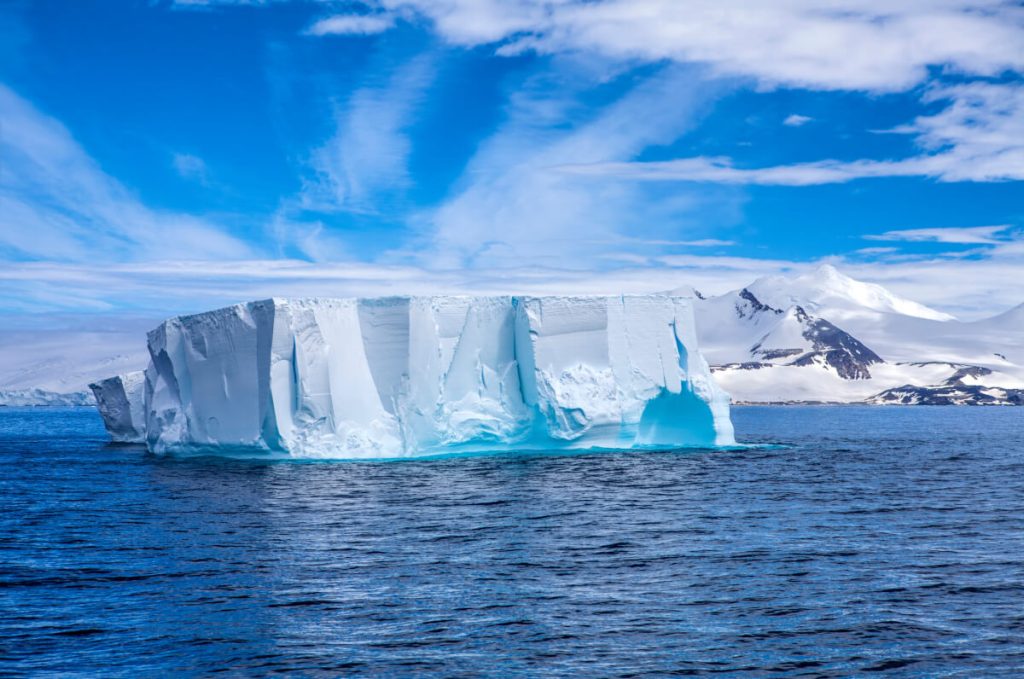

Antarctic iceberg floating (unrelated to study) in the ocean.. (© marcaletourneux – stock.adobe.com)
UTRECHT, Netherlands — Some experts fear a massive drifting iceberg known as A23a is currently on a collision course with South Georgia Island, threatening to disrupt the breeding grounds of penguins, seals, and albatrosses that call this remote South Atlantic outpost home. Scientists are closely monitoring its path, concerned that in the unlikely case it collides with the island, it could block countless animals’ access to their foraging waters. While this particular iceberg’s journey is capturing headlines today, research from Utrecht University reveals that icebergs have been making similar voyages for millions of years — and their ancient travels are helping scientists rewrite the history of Antarctica’s ice.
The modern-day drama of iceberg A23a, which broke off from Antarctica’s Filchner ice sheet in 1986 before becoming grounded for decades and recently beginning to drift again in 2020, provides a visible reminder of how climate impacts the frozen continent. But according to this latest study, published in Climate of the Past, icebergs were already navigating these southern waters more than 36 million years ago, during a period when Antarctica was previously thought to be largely ice-free.
For decades, scientists believed Antarctica’s first large ice sheet formed around 34 million years ago during the Eocene-Oligocene transition. This cooling event transformed the continent into the frozen landscape we know today. The Utrecht researchers are now challenging this timeline. By analyzing ancient ocean sediments and simulating iceberg movements, scientists found that Antarctic icebergs may have been drifting northward at least 36 million years ago—suggesting parts of the continent were already glaciated millions of years earlier than previously assumed.
The key evidence comes from ice-rafted debris (IRD) discovered at Ocean Drilling Program (ODP) Site 696, located on the South Orkney Microcontinent. These tiny rock fragments, carried by icebergs and deposited when they melted, were found in sediments dating back 36.5 million years. This discovery puzzled researchers—how could Antarctic icebergs have existed in an era once thought too warm for significant ice formation?


Tracing Icebergs in the Late Eocene
Utrecht University student Mark Elbertsen took on this geological mystery as part of his Master’s thesis, working with supervisors Peter Bijl and Erik van Sebille. Using advanced computer models, the team simulated how icebergs of different sizes would move and melt in the late Eocene’s warm oceans.
Their simulations confirmed that only very large icebergs—at least 100 megatons in mass and several tens of meters thick—could have survived long enough to reach the South Orkney Microcontinent. Smaller icebergs would have melted too quickly in waters that were significantly warmer than today’s Antarctic seas. Wave-driven erosion, which stripped away 10–20 meters of ice per day, accounted for up to 80% of iceberg mass loss. This meant that even massive icebergs had lifespans of just a few months—far shorter than modern icebergs of similar size, which can last for years.
Importantly, the team’s models aligned with geological evidence. The mineral composition of the ice-rafted debris matched bedrock found in the southern Weddell Sea region, near the present-day Filchner Ice Shelf and Dronning Maud Land. This suggests that icebergs from these areas carried the debris to South Orkney, further supporting the idea that parts of Antarctica were already glaciated before the Eocene-Oligocene transition.
“Although this places the iceberg mass at the larger end of the present-day range of common iceberg masses around Antarctica, the minimum estimates are not unfeasible,” the researchers note in their paper. In other words, while such icebergs would be on the larger side of what we observe today, they’re certainly not beyond what glaciers can produce.
The melt rates for these Eocene icebergs were dramatically higher than what we observe in the modern era. With sea surface temperatures around Antarctica reaching about 10°C during the late Eocene (compared to near or below freezing today), icebergs melted much faster. The researchers calculated that most icebergs of moderate size would have completely melted within about 7 months – far shorter than the multi-year lifespans of similarly-sized icebergs in today’s colder oceans.


Wave erosion proved to be the dominant factor in iceberg melting, accounting for the majority of ice loss as warm waves constantly battered the icebergs’ sides. The simulation showed wave erosion rates between 10 and 20 meters per day – substantially higher than rates observed in modern oceans.
Despite these challenging conditions, the modeling demonstrated that sufficiently large icebergs could have survived the journey, particularly if they traveled along pathways similar to today’s “Iceberg Alley” – a corridor where Antarctic icebergs commonly drift northward, guided by ocean currents. Remarkably, the position of ODP Site 696 during the late Eocene appears to have been situated in a location analogous to today’s Iceberg Alley, making it ideally placed to receive ice-rafted debris.
The researchers cross-referenced their modeling results with geological evidence, comparing the likely source regions of icebergs with the mineral composition of the ice-rafted debris found at ODP Site 696. Previous analysis of these rock fragments had pointed to the southern Weddell Sea region as the most likely source, which aligns perfectly with the model’s prediction that icebergs from the Filchner Ice Shelf region and Dronning Maud Land could reach the South Orkney Microcontinent.
This alignment between geological evidence and computer modeling provides compelling support for the existence of marine-terminating glaciers along portions of Antarctica’s coast during the late Eocene. Since icebergs only form when glaciers extend to the ocean, this indicates substantial ice accumulation occurred in certain regions – even during this relatively warm period.


How Did Ice Exist in a Warmer Climate?
The researchers suggest that increased snowfall may have played a key role. A stronger hydrological cycle, driven by warmer temperatures, could have led to more precipitation over Antarctica, allowing glaciers to accumulate at high altitudes where temperatures remained low. These glaciers may have gradually advanced to the ocean, calving icebergs that drifted northward.
This finding adds to a growing body of evidence that Antarctic glaciation did not happen suddenly at 34 million years ago, but rather developed gradually, with localized ice caps forming in specific regions under the right conditions.


Understanding how ice sheets responded to past climate conditions can help predict how they might react to modern global warming. While today’s climate is changing much more rapidly than past transitions, insights from ancient icebergs can provide valuable clues about the thresholds that lead to glacial growth or retreat.
Elbertsen’s supervisors, Bijl and van Sebille, are now expanding their research through the EMBRACER climate program, investigating past iceberg calving events during periods of rapid warming. By studying how meltwater from icebergs affected the Southern Ocean in the past, they hope to improve models of how Antarctica’s ice sheets might behave in the coming decades.
What Will Happen to Iceberg A23a?
This study provides compelling evidence that Antarctic glaciers existed millions of years earlier than traditionally thought. While it does not mean the continent was fully glaciated at that time, it suggests that some marine-terminating glaciers—large enough to produce icebergs—formed under warmer conditions than previously believed.
By combining geological data with sophisticated computer modeling, this research helps refine the timeline of Antarctic glaciation and improves our understanding of how ice sheets evolve in response to climate changes. As scientists continue to uncover Antarctica’s deep past, these insights will be crucial in predicting the future of our planet’s frozen landscapes.
While iceberg A23a will likely run aground on the shallow waters surrounding South Georgia Island rather than directly colliding with it, scientists continue to monitor its progress closely. If it does become grounded, the iceberg’s presence might actually benefit local wildlife colonies by creating nutrient-rich currents around it, bringing more food to the area.
Paper Summary
Methodology
The research team used a sophisticated approach called Lagrangian iceberg tracking to simulate how icebergs would move and melt in a late Eocene ocean. This method follows individual icebergs as they drift with ocean currents while gradually melting from contact with warm water and waves. The researchers used a high-resolution ocean model of the late Eocene (from about 36.5 million years ago) that could capture small-scale ocean features like eddies and currents with remarkable detail. The model represented icebergs as cuboid (box-shaped) objects with realistic dimensions and densities based on observations of modern Antarctic icebergs. The researchers simulated five different size classes of icebergs, ranging from small (17 meters long) to massive (100,000 meters long), and tracked how three key melting processes would affect them: basal melt (melting at the iceberg’s bottom), buoyant convection (melting along submerged sides), and wave erosion (melting at the waterline). The simulation included both forward tracking (releasing icebergs from Antarctica and seeing where they ended up) and backward tracking (working backward from the sediment site to determine where icebergs might have originated).
Results
The simulations revealed that only icebergs of significant size could have survived the journey from Antarctica to ODP Site 696 where the ice-rafted debris was found. Specifically, icebergs needed to be at least size class C3 (1,000 meters long, 200 meters thick) or C4 (10,000 meters long, 500 meters thick) to reach the site before completely melting. Smaller icebergs melted away long before reaching the South Orkney Microcontinent. The most likely source regions for these icebergs were determined to be the area offshore of the present-day Filchner Ice Shelf and Dronning Maud Land. Icebergs from these regions followed ocean current patterns similar to today’s “Iceberg Alley” to reach the deposit site. The minimum iceberg size required at these source regions was estimated to be around 100 megatons with a thickness of several tens of meters. While this represents the larger end of commonly observed modern Antarctic icebergs, such sizes are entirely feasible. The simulations showed that even the surviving icebergs melted much faster than modern ones, with average lifetimes of just 2-12 months compared to several years for similar-sized icebergs today. Wave erosion was the dominant melting process, contributing up to 80% of total iceberg melt.
Limitations
The researchers acknowledge several limitations to their modeling approach. They approximated icebergs as perfect rectangular blocks, which likely underestimates melt rates compared to irregularly shaped real icebergs. The model did not include the effects of wind drag directly on the icebergs, which could affect smaller icebergs’ trajectories significantly. Monthly wind stress data was used instead of daily values, potentially underestimating wave erosion by about 31% on average. The model also couldn’t simulate iceberg breakup events, which are known to significantly affect iceberg lifetimes in the real world. Additionally, the late Eocene climate model used for the simulations did not include the cooling effects that ice itself would have had on local temperatures. This means the ocean temperatures in the simulation might be somewhat warmer than they actually were if ice sheets were present, potentially making iceberg survival more difficult in the model than in reality.
Discussion and Takeaways
This study’s findings support a growing body of evidence that Antarctica wasn’t entirely ice-free until the major glaciation event at the Eocene-Oligocene boundary (around 34 million years ago). Instead, significant ice masses likely existed in certain regions millions of years earlier. The research demonstrates that icebergs calved from marine-terminating glaciers along the Antarctic coast could have transported debris to the South Orkney Microcontinent during the late Eocene, despite the relatively warm ocean temperatures. The fact that these icebergs needed to be quite large to survive the journey suggests that substantial glaciers capable of producing sizeable icebergs existed along parts of Antarctica’s coast. This contradicts the traditional view of a completely ice-free Eocene Antarctica. The findings are consistent with other evidence suggesting that glaciation might have proceeded more gradually through the Eocene, with ice sheets potentially forming during cooler intervals such as the Priabonian Oxygen Isotope Maximum around 37 million years ago. The research also highlights the importance of regional topography and precipitation patterns in enabling glaciation even during generally warm climate periods. High-altitude regions with substantial snowfall could have maintained glaciers despite elevated global temperatures.
Funding and Disclosures
This research was supported by the European Research Council under the Horizon 2020 European Research Council grant number 802835. The authors did not report any competing interests that might have influenced the research.
Publication Details
The study, titled “Possible provenance of IRD by tracing late Eocene Antarctic iceberg melting using a high-resolution ocean model,” was conducted by Mark V. Elbertsen, Erik van Sebille, and Peter K. Bijl from Utrecht University in the Netherlands. It was published in the journal Climate of the Past (Volume 21, pages 441-464) in February 2025. The paper is distributed under the Creative Commons Attribution 4.0 License and is publicly accessible. The DOI for the paper is 10.5194/cp-21-441-2025.








